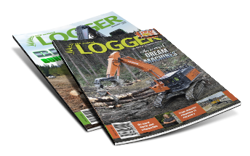The strength of rope required to successfully extract trees from the forest over a long distance results in larger diameter ropes being used. Wire rope has traditionally been used for cable logging because of strength and durability characteristics, but it is very heavy for forest workers to handle, making it time-consuming and physically demanding to work with. Rigging accessories required are also large and robust, and the weight of the rope and carriage over a longer reach is detrimental to payload capability.
Modern cable logging operations are fast and productive, but this movement of the rope and the higher loading means they are susceptible to fatigue. Improvements in fibre rope provide opportunities for a significantly lighter rope to be used. In New Zealand synthetic rope is already common as strawline on yarders, in central Europe as guylines and in Eastern Europe for cable skidders.
Synthetic rope has several benefits compared to traditional steel rope; a very high strength to weight ratio, reduced manual workload and easier to handle and repair. However, synthetic rope has low abrasion resistance and costs more.
Put to the test
Professor Rien Visser from the University of Canterbury was able to support his Norwegian colleague, Dr Halvor Torgesen, in evaluating an Ultra-High-Molecular-Weight Polyethylene (UHMWPE) fibre rope in a downhill, running skyline, cable logging operation. The equipment used was a forwarder mounted Owren T3 cable crane with a running skyline, owned and operated by Rørvik Taubanedrift AS from Norway. The yarder has a pulling force of 5 tonnes and a drum diameter of 400mm.
The fibre rope tested was 12mm diameter, 0.11kgm and with a minimum breaking load of 17.7 tonnes. This was used for both the main and haulback lines. The cost of the fibre rope used in this study was just over twice that of the equivalent steel rope.
By using synthetic rope, the running skyline configuration could use a customised slack-pulling carriage weighing only 35kg, with a 50m line for lateral hauling. This was a significant weight saving as the carriage required for a wire rope was a 360kg Owren drum carriage.
The extraction was whole trees; run by a team consisting of a winch operator, a harvest machine operator, one chainsaw worker and one choker-setter. The yarding study took place in two different forests (Frøyset and Herje, west coast Norway) harvesting Norway spruce. At one site logging was more challenging as it was close to live 22kV power lines, but the use of synthetic rope reduces the risk of arcing. The average tree sizes were 0.41 m3/tree and 0.51 m3/tree on; small trees by New Zealand standards. As they were building loads using typically 3 chokers, loads were 1.7-2.6m3 which is similar to many larger scale grapple operations here. The extraction distances were between 240 and 440m and lateral hauling was up to 50m.
Synthetic rope chokers were also used. During operations, there were a few breaks at the end of the dropline where the sliding sling lines (chokers) were being attached. To solve this, the rope was spliced to double...





